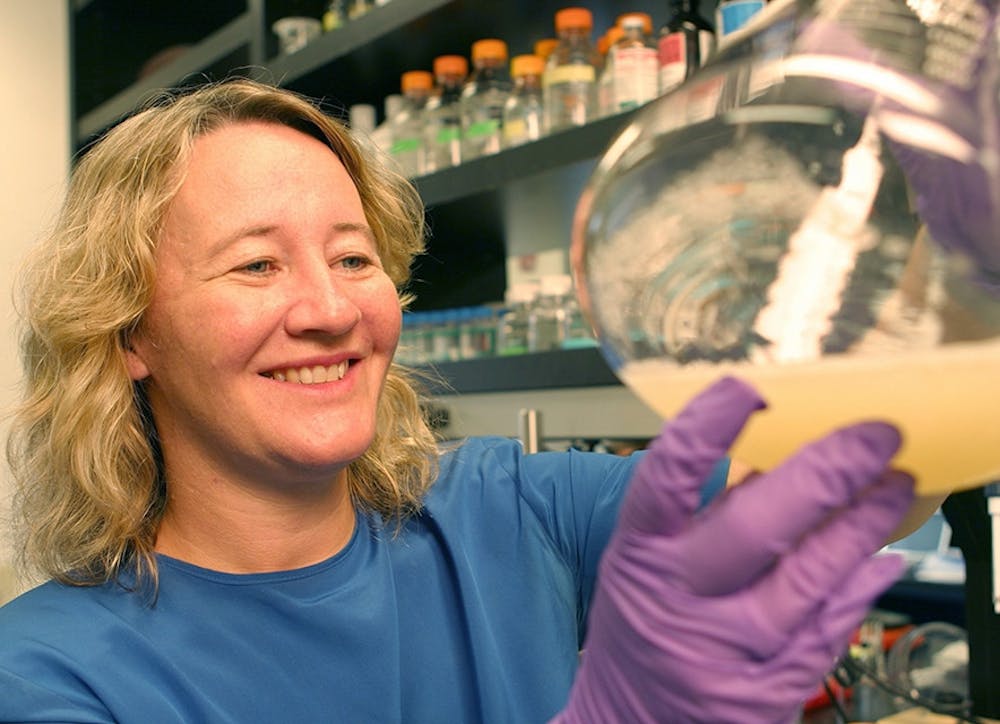Nobel Laureate Carol Greider gave a lecture last week on how she helped solve one of molecular biology’s fundamental mysteries: why are germ cell lines immortal?
In the 1960s, biologist Leonard Hayflick noticed that adult human cells in a Petri dish can only divide 40 to 60 times until they stop growing. This discovery uncovered a paradox: we are all products of cell lineages that go back millions of years and cell divisions, but our adult cells can only divide a limited number of times. How do germ cells, which are the reproductive cells passed on by parents, reset this ticking biological clock?
Carol Greider discovered the answer in graduate school at the University of California, Berkeley while working in the lab of Elizabeth Blackburn, who shares her Nobel Prize in Physiology or Medicine. Just before Greider’s arrival, Elizabeth Blackburn had discovered an important genetic element called telomeres.
Telomeres are protective sequences of DNA at the end of our chromosomes. Due to the peculiarities of DNA replication, the ends of chromosomes shorten every time they are replicated. Telomeres are a non-coding buffer zone; when chromosomes shorten, telomeres are whittled away instead of important genes. Telomeres also attract important binding proteins that prevent the ends of different chromosomes from joining, and stop harmful DNA enzymes from digesting DNA. Just as shoelaces begin to fray when their plastic tips fall off, chromosomes begin to decay when their telomeres shorten.
Elizabeth Blackburn’s observation explained why adult cells have a limited number of cell divisions: their chromosomes shorten and their telomeres disappear. But how are germ cells able to regenerate their telomeres and pass on healthy telomere fortified DNA to their offspring?
Greider hypothesized that there was an enzyme capable of elongating telomeres in germ cells. She investigated the elongation mechanism with the model organism Tetrahymena, a single-celled animal from the protazoa kingdom. To search for the enzyme she collected extracts from the cells, and added them to artificial telomere sequences (repeating TTGGGG nucleotide bases) to see if they were elongated.
“After about nine months of trying variations on experiments, we found our first strong evidence for telomere elongation,” Greider said. “An 18 nucleotide telomere ‘seed’ was elongated with a repeated sequence that was six bases long – precisely the length of the TTGGGG telomere repeat in Tetrahymena. Now we had a biochemical assay that we could use to determine if this was a new telomere elongation mechanism.”
Next Greider hunted for the telomere elongating protein’s gene and for its mechanism. She suspected it used DNA’s relative, RNA, as a template to extend the telomere ends. She added RNA degrading enzymes to the protein extract and tried her experiment again: the telomeres didn’t extend.
“The RNA experiments indicated that activity was eliminated when RNA was degraded, implything there was an RNA component,” Greider said. “Liz and I felt that the best way to really show that an RNA was involved was to find the actual RNA. So I went into the cold room to try and purify the enzyme.”
After several years of work at UC Berkeley and at a fellowship at the Cold Spring Harbor Laboratory in Long Island, NY, Greider discovered the structure of the telomere enzyme, its gene and its mechanism. For this she was awarded the Noble Prize in Physiology or Medicine in 2009.
Greider named the telomere elongating enzyme telomerase, an unusual name for an enzyme.
“We first called the activity we identified ‘telomere terminal transferase’ because it was transferred telomere sequences into termini, but later shortened it to ‘Telomerase,’” wrote Greider in her biography on the official Nobel Prize website. “My friend and fellow student Clair Wyman and I would joke around in the lab a lot. Claire pointed out the name was too long and suggested various humorous names as alternatives. Names were further discussed later that night over a few beers and telomerase was one Claire had proposed initially as a joke. She thought it was funny, but Liz and I both liked it.”
Greider verified her discovery of telomeres and telomerase through experiments with telomerase deficient mice. She created a telomerase “knock-out” version of mice in which they lacked the enzyme telomerase. The mice were able to develop and have offspring normally for the first four generations, but the fifth and sixth generations of mice had growth defects. The sixth generation was completely sterile. The results aligned with her theory. The telomeres of the mouse reproductive cells diminished in each passing generation, until they were too short and their genetic information was damaged. When she mated the fifth generation mice with control mice so that their offspring would have a version of the telomerase gene, the sixth generation of mice was able to regenerate their telomeres. The experiment neatly summarized her decades-long and Noble Prize-winning work on telomerase.
The College is fortunate to have hosted several excellent lecturers this year, including two noble laureates. It is incredible not only to learn about their discoveries, but also to see the people behind the science and hear the stories that led them to their insights.
Science Spotlight: Nobel Laureate Carol Greider

Comments



